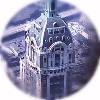
|
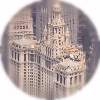
image
THE MUNICIPAL BUILDING (1 Centre St.)
[McKim, Mead & White, William M. Kendall as chief designer]
|
was built in 1909-1915 as the joint administration offices for the
Greater New York, created after the annexation of Bronx, Queens,
Brooklyn and Staten Island (Richmond) to Manhattan in 1898.
After two inconclusive design competitions to replace the City Hall
in 1888 and 1893, and after a law was signed that prohobited the
replacement of the old City Hall in 1894, the site of the 1907
competition was shifted to a plot to the north-east, originally meant
for an extension of the Brooklyn Building trolley terminal.
The selection was made in 1908 and the next year work on this
behemoth with 60,400 m² of office space -- a feature that helped
the design to win the competition -- was begun. The first occupants
moved to the building in January 1913, two years before work on it
was completed.
The building was influenced by the fashionable "City Beautiful"
movement of the 1890s which promoted plans for creating public
buildings in landscaped parks. The mid-part of the 25-storey
tripartite facade is a U-shaped mass of austere light-toned granite
over a high colonnade that forms the building's base and separates
a front yard from the sidewalk. The top portion of the building
features a colonnade of Corinthian columns and pilasters.
The 16-storey top, above the middle section of the building,
consists of a set-back tiered lantern on top of a square base,
flanked by four smaller pinnacle turrets, symbolizing the four
boroughs joined to Manhattan. At the height of 177 m stands the
6 m high statue Civic Fame by Adolph A. Weinman, New York
City's second largest statue after the Statue of Liberty.
This building impressed Josif Stalin so much that the Moscow
University main building (1949-1953) was later based on it -- as
well as, in general, the whole grandiose public building style in
the Soviet Union.
The building has an entrance to the Chambers Street subway station
(1915), the first of many such connections to come. An archway leads
through the mid-facade (a closed portion of Chambers St.) to the
Police Headquarters across the landscaped Police Plaza.
The building was landmarked in 1966.
|
images


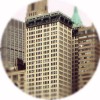
image
THE ADAMS EXPRESS BUILDING (61 Broadway)
[Francis H. Kimball]
|
was built in 1914-1916 for the Adams Express Co., a parcel delivery
service.
Occupying its whole plot, the 60,700 m² building rises perpendicularly
for 33 stories and the south facade is recessed in the middle to allow
in more natural light.
The windows are grouped in series of four throughout and the building
is topped at 129 m with massive cornices of green colour.
The building underwent a $14 million renovation in 1986.
|


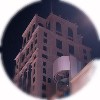
image
THE CANDLER BUILDING (220 W 42nd St./221 W
41st St.)
[Villauer, Shape & Bready]
|
was built in 1914 for Coca-Cola Company's Asa Candler, as a monument
for his sales successes.
The neo-Renaissance office tower is clad in white terra-cotta tiles,
with arched triple windows rising the height of the 24-storey 42nd
Street facade. There are four corner terraces flanking the cruciform
top floor which is covered by a similarly cruciform hipped roof and a
flagpole.
At the time of its completion, the 107 m tall building was the tallest
in NYC north of the Metropolitan Life Insurance
Company Tower near Madison Square.
With its immediate Times Square surroundings undergoing drastic
changes in form of renovation, alterations and new construction,
the building has been retained as a 42nd Street landmark, with
appropriately, the 41st Street entrance sporting a large canopy
proclaiming the ground-floor space as a "McDonald's".
In August 2002, the 20,000 m² building was put on the auction
block, it being expected to yield around $80 million.
|


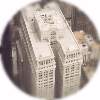
image
THE EQUITABLE BUILDING I (120 Broadway)
[Graham, Anderson, Probst & White, Ernest R. Graham as chief designer]
|
was built in 1912-1915 for the Equitable Life Assurance Society.
The building was in fact made to the second plans for a skyscraper to
the site: in 1908 Daniel H. Burnham (designer of the
Flatiron Building)
had designed a 62-storey tower of 323 m, but the project was
postponed, and after the old company headquarters had burned down in
1912 -- and steps behind the scenes
taken -- eventually, the 166 m
tall design by Ernest R. Graham was built.
The neo-Renaissance building occupies the whole block, and rising in
two masses above the base and connected by a wing for the building's
whole height, forms a giant letter "H" when viewed from above.
The height of the building was decided upon after consulting with
elevator engineer Charles Knox, who determined the optimum number of
floors for effective elevator service in the building. This resulted in
reducing the number of floors from the originally planned over 40 to
36. This was one of the first buildings where the number of floors in a
skyscraper was determined by such calculations.
At the time of its completion, the building caused resentment due to
its massive scale (housing over 111,000 m² of office space, a
FAR equivalent of 30!), and for blocking
sunlight from the street. The outrage subsequently led to the
restriction of continuous vertical growth of tall buildings by the
introduction of the 1916 zoning
regulations by city authorities. An indication of the bulk of the
building was the fact that it remained the largest office building (by
internal volume) in the world until the Empire
State Building of 1931.
The through-block entrance lobby has a pink marble floor,
sandy-coloured marble walls and a vaulted, coffered ceiling. The
building with its 5,000 windows once housed the exclusive Bankers Club
on its top three floors.
|
images



image
THE BUSH TOWER (130 W 42nd St.)
[Helmle & Corbett]
|
or the Bush Terminal International Exhibit Building, was built in
1916-1918 for the Bush Terminal Company.
The 29-storey building housed not only offices for various
manufacturer and goods trader firms, but also acted as a haunt for
executives with its heavily decorated clubroom and restaurant.
The building site is only 15 m wide and 27.5 m deep, and the architects
remarked that they wanted to make the building "a model for the tall,
narrow building in the center of a city block." And it was regarded
as such for the next decade of feverish urban construction.
The style of the building follows the "traditional" early skyscraper
style with its Gothic appearance -- English this time. On the side
facaces, trompe l'oeil brickwork creates vertical "ribs" with a
fake "shade" pattern to enhance the verticality. The windows are
concentrated to the north and south facades, as well as to a recessed
mid-facade light-well on the east facade.
At 146 meters, a set-back top houses the top floor with its high arched
windows for Bush's personal offices as well as the water tower.
The interior decor comprised of extensive oak panelling, oriental
carpets and antique furniture.
The building was acquired in the 1980s by the Lebanese Dalloul family's
American Properties.
In 2002, plans for a sister building immediately to the west were
publicized. In a design by Gruzen Samton, a 23-storey glass
tower would be separated by a 15 cm gap -- necessitated by the
earthquake codes -- bridged over on every floor to double the original
building's space.
|


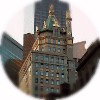
image
THE CROWN BUILDING (730 Fifth Ave.)
[Warren & Wetmore]
|
was built in 1921 as the Heckscher Building to the corner of Fifth
Avenue and 57th Street.
Along with the primary developer August Heckscher, a philanthropist
and failed advocate of low-income housing programmes, also the
architect, Charles A. Wetmore was investing on the building
himself.
This mixed-use building was the first office deveopment resulting
from the 1916 zoning variation. The
26-storey building's lower part follows the existing property and
roof lines of the low-rises, after which it sets back to the French
Renaissance tower with an octagonal pyramid roof and a tall chimney,
both with gilded details. The rooster figure at the top was removed
in 1942, to be melted for the war effort.
The barrel-vaulted lobby was built small to maximize the retail
space, especially profitable in this area of Midtown.
The then Met apprentice, Museum of Modern Art, opened its first
exhibition spaces here in 1929 (today, they have more boasting
surroundings, also in tower architecture).
|
The Cityreview
entry


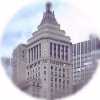
image
THE STANDARD OIL BUILDING (26 Broadway)
[Carrére & Hastings and Shreve, Lamb & Blake]
|
was built in 1920-1928 as the headquarters for the Standard Oil of New
Jersey.
The neo-Classical building was constructed in stages to fill the
southern portion of the block and the Broadway facade follows the
street's curvature. The tower, with its stepped pyramidal roof above
a colonnaded top, is at an oblique angle to the rest of the
building, aligned with the island's regular grid.
The lobby, lined with pilasters and columns, sports the names of the
founders of the oil company, including John D. Rockefeller. The
Standard Oil Clock shows hours with the letter 'S' and minutes with the
'O'.
The building was vacated by the Standard Oil in 1956, when the company
moved to the Socony-Mobil Building in
Midtown.
|


ENTRANCE
CONTENTS
INTRODUCTION
ALPHABETICAL LIST
EARLY CENTURY I &
II
ART DECO ERA I &
II &
III
INTERNATIONAL STYLE I &
II &
III
POST-MODERNISM I &
II
NEW DEVELOPMENTS
ADDITIONAL INFO I &
II &
III &
IV
ARCHITECTS
DEVELOPERS
TOPICS INDEX
FORUM
LINKS
SITE SEARCH
MAPS:
DOWNTOWN
VILLAGES
WEST MIDTOWN
EAST MIDTOWN
UPTOWN
 © e t dankwa
25 March 2006
© e t dankwa
25 March 2006
|
![]()

![]()
